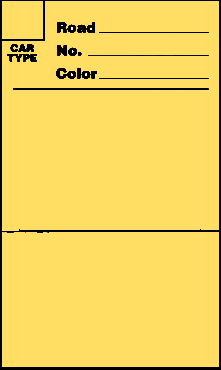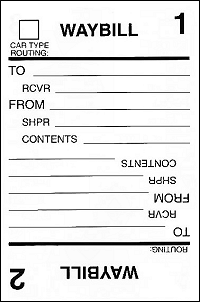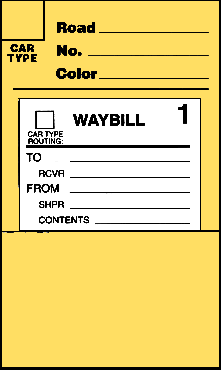|
Card Order |
|
|
What is a card order? It is the organized movement of railroad cars
between industries following prototypical railroad operations through the
use of waybills which act as a train order. |
|
During the railroad's construction, the operation of the railroad rather
than just riding around on it was a major goal, especially for those
doing the construction work. As construction progressed, sidings were
planned and added that were helpful to set out work cars during the
construction process and later as industrial sidings. There are even
railroad industrial parks designed like the Allen time saver switching
problem to service multiple industries. |
|
With a railroad spread out over 35 acres with several branches, up to six
local freight trains can operate at the same time without interfering
with each other during switching and often are not even within sight of
each other. |
|
As of 2009, there are over 60 different locations to spot cars at over
50 different industries. Several industries have multiple locations to
spot a variety of cars. |
|
| Positions and Duties |
|
|
The card order functions are dependent on the number of participants and
may be modified as the day progresses. |
|
| Trainmaster |
|
A trainmaster oversees the entire operation, assigns new waybills as
necessary, settles any questions that may arise, approves position
requests and insures adequate manning of key positions. |
|
| Dispatcher (optional) |
|
A dispatcher handles train movements via radio on the mainline during
high volume sessions, operates on channel 5 out of the Saddleback
Pavilion to be able to monitor entire railroad and should have
additional radios to contact yards without changing channels. |
|
| Yardmaster(s) |
|
The yardmaster oversees all movements within yard, sorts incoming cars
according to the next waybill assignment, has trains assembled by yard
crew for local and through freight runs and keeps track of dispatched
trains by locomotive road number, local destination assigned and time
departed. |
|
| Yard Engineer |
|
A yard engineer sorts cars in the yard area according to the
yardmaster's directions, assists in making up outgoing trains and
switches the local industries adjacent to the yard area. |
|
| Yard Crew |
|
The yard crew oversees all of the movements within the yard, sorts
cars and assembles trains for local and through freight runs and sorts
incoming cars according to the next waybill assignment. |
|
| Passenger Train(s) |
|
The passenger train crews are an engineer and a conductor. They follow
the timetable schedule around a assigned route. May not depart or pass
any station early. If they are running over 10 minutes behind schedule,
that train looses priority and continues on as a non-scheduled
extra. |
|
| Through Freight |
|
The through freight crew consists of an engineer and a conductor. They
move cars between Eagle Point yard and Cumberland yard and may be
required to assist the yard crews with switching at either yard. They
keep track of the passenger train schedule and do not occupy a block
that will delay the passenger train's movement. |
|
Local Freights |
|
The local freight crew consists of an engineer and a conductor. They
move cars according to waybill orders to industries with the assigned
local run. They picks up and return to the originating yard with the
same number of cars as they were dispatched with. The return cars are
picked up from industries within their assigned local area. The local
freight train keeps track of the passenger train schedule and does
not occupy a block that will delay any the passenger train movement.
They may not roam the railroad freely. |
|
| Local Freight Conductor |
|
The local freight conductor controls all of their train's movements.
They manage the car waybills and follow the instructions on the
waybills while insuring that the car is spotted at the proper location
at the industry. Several industries do have multiple positions to spot
cars. The conductor picks up the returning cars from within their
assigned local division. They keep the train clear for scheduled trains
moving through their working area. |
|
| Local Freight Engineer |
|
The local freight engineer follows directions of the conductor for all
train movements. They make all switching movements at slow speed
making sure all people are aware of pending movements. They do not move
the train if instructions are not clearly understood. |
|
| Local Freight Train Crew |
|
The local freight train crew follow directions of the conductor.
The brakeman/switchman handles couplings and chains when switching
cars. They may need to flag per the conductor's instruction. |
|
| Extra Help |
|
During sessions when extra people are available along with high
traffic volume, extra available people may be assigned as assistants to
almost any position except the position of engineer. |
|
| Unassigned Extras |
|
Please remain out of the yard areas, including the EP crossing, so the
crews can see and work unobstructed. |
|
|
| Session Basics |
|
|
Some positions are more desirable than others and requests for certain
positions may be submitted to Trainmaster. Some key position must be
filled in order for a session to work. If a key position becomes
shorthanded, the Trainmaster may temporarily reassign people as necessary
to keep operations going. |
|
The card order operations run through lunch with no set lunch break. The
crews take a break between runs at their leisure. |
|
Basically, there is a waybill for each car in a short train. In most
cases, there are only four cars. The local freight's job is to deliver
the correct car to the correct spot at the industry listed on the waybill
and pick up cars in their assigned local area to return to the
yard. |
|
|
|
|
| Car card |
|
In the above images, the image on the left is a card with a pocket
that lists the details of each railroad car used. It includes the type
of car, the reporting marks and car number. The card pocket holds the
waybill with movement orders and only the current movement order is
visible when in the pocket. |
|
| Waybill |
|
In the above images, the middle image is an example of a waybill.
These are the orders that instruct you where to take the car; location
and industry. One note is that some of the large industries have
multiple tracks or positions to spot cars. The cards have up to four
sets of instructions, so the car may be moved up to four times to
different industries. After the forth move it can go back to position
#1 or receive a new waybill. The train crews only follow the waybill
shown. The yardmaster is reponsible for turning the waybill when the
car is returned to the yard. |
|
| Industry Map |
|
The industry strip map indicates the location of all industries on the
railroad and the orientation of the siding for each. It also shows the
division or local run area for each local run as all industries
included may not be grouped within sight of each other. |
|
| Local Freight |
|
This is a train that switches the cars between the yards and
industries. A local run is assigned to work one area of the railroad. A
local has a crew of two to four people; a locomotive car, a engineer's
car, a crew car(s) and a caboose. They are normally sent out with four
freight cars for delivery to one local area. |
|
| Through Freight |
|
When the second yard at Cumberland is in use, this is a freight train
that runs between yards with an engineer and conductor. It could haul
4 to 10 or more cars at a time. It may also run on a regular schedule
during busy sessions. |
|
| Passenger Train |
|
This train departs Eagle Point every hour and has specific route with
scheduled stops over most of the railroad. Local and through freights
must keep track clear to allow passenger train to pass without any
delay. |
|
| Radio Usage |
|
All operations are on Family Service Radio (FSR) systems. The main
operating frequency for the railroad is 5.0 or channel five, eliminator
code zero. |
|
|
| Train Master |
| |
5.0 |
| Dispatcher |
| |
5.0 |
| EP Yard Crew |
| |
4.0 |
| Cumberland Yard |
| |
3.0 |
| Passenger Train |
| |
5.0 |
| Through Freight |
| |
5.0 |
| Local Freights |
| |
any available other than 3, 4, & 5 |
|
|
|
If locals trains use radios to help in switching while out on runs,
they need to advise the dispatcher (or yardmaster if no dispatcher) of
the channel they will be using. Only one local freight per channel (not
channels 3, 4 or 5). |
|
|
| Eagle Point and Cumberland Yard Operations |
|
|
If yard radios are used, the Eagle Point yard works on channel 4.0 and
the Cumberland yard works on 3.0. Both yards should monitor
5.0 |
|
| Eagle Point Yard Operations |
|
|
The Eagle Point (EP) yard at the west end of the railroad is the main
yard and is laid out to function as a single yard or primary yard during
card order. When the Cumberland yard at the east end of the railroad is
operational, the EP yard is the primary yard and will usually dispatch
all local freights working between Eagle Point and Saddleback, including
the Tracy City branch. The Cumberland yard will usually manage local
freights to Allen, Leathergap-Cumberland and Sequatchie. Crews working
locals will rotate working assingments out of both yards. |
|
The eight track EP yard is a small yard with high capacity. Operating at
full crew capacity, it can handle eight, four-car local freight set ups,
two outbound local freights preparing for departure and a freight
inbound into the yard simultaneously. |
|
Outbound train crews wanting to enter the yard to obtain a train
assingment need to hold on the south leg of the EP wye until cleared by
the yard crew to enter. They go to the end of track #7 or 8 as directed,
where their cabooses and rear crew car will be picked up by yard
crew. |
|
Inbound trains returning from an assingment must contact the yardmaster
before entering the shop loop block. Do not proceed around the loop just
because the block is green. |
|
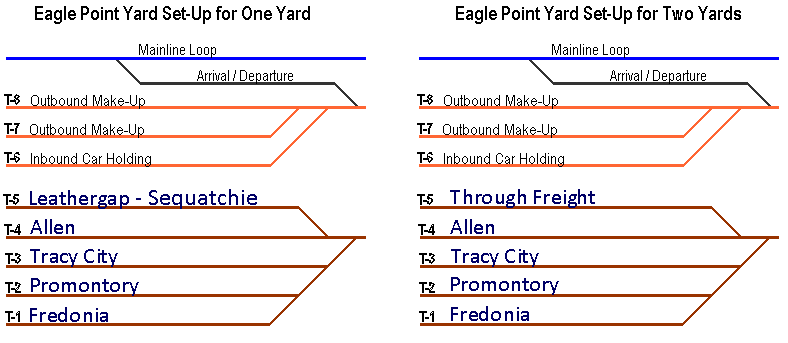 |
|
| Yard Crew Information |
|
|
The Eagle Point yard is essentially divided into two sections; the top
three tracks #6-8 are for arrival and departure, make up and break down.
The bottom five tracks are for sorting cars. At no time are any yard
tracks available for parking trains other than assigned yard
locomotives. |
|
An arriving train drops their caboose on the arrival/departure track,
backs the cars into track #3, retrieves their caboose and exits the east
end of the yard, goes left on the Eagle Point wye and then backs down to
the south yard to wait for another assignment. The yard switcher is not
necessary for dropping inbound cars. |
|
Departing or outbound trains are made up on tracks #1 and #2. When
called for by the yardmaster, the locomotive and caboose pulls into the
assigned track, all the way to the end. The yard switcher picks up the
caboose and rear crew-car, if any, and proceeds to pick up the assigned
car set ready on tracks #1 thorough #5. The switcher moves the cars back
to the makeup track and then goes on to the next task. The outbound train
crew checks the car-cards, waybills, safety chains and goes over train
assignment. They are out of the way and may take as much time as
necessary to get everything ready like getting drinks, radios, cameras,
batteries, BEFORE departing. Once they are ready, they inform yardmaster
and once cleared, back up until they are clear the departure track
turnout and then exit the yard without delay. |
|
When the yard crew is not moving cars from sorting to departure to make
up outgoing trains, they are sorting cars for future outgoing locals.
Track #6 (inbound track) should be cleared as soon as possible to keep it
open for arriving trains. The cars should be sorted into local freights
as indicated on the waybill after Yardmaster has turned or replaced the
waybill; or when 2nd yard is in use, set on #5 for Through-Freight to
Cumberland if waybill indicates next stop is dispatched from
Cumberland. |
|
Humping is allowed on tracks #1 thorough #5 if there is enough yard crew
on hand and they are in contact visually and by voice or radio and
understand each move. Do not hump if people are standing around blocking
crews view. Only yard crew should be in yard area when humping.
Yardmaster calls out the track a car goes on and once the turnout is set
and there is a person to catch the car, it may be released. Multiple cars
can be humped together to the same track. Multiple cars can be released
to different tracks if there is someone to catch each car and the
turnouts are aligned after the first car passes. Do not stop to hook up
couplers or chains until all cars are humped and have stopped
rolling. |
|
Should the yard become overfilled on the sorting or holding tracks, up to
90' of cars may be moved to the spare passenger station track. |
|
The yard crew may also responsible for switching the industries adjacent
to the arrival departure track. |
|
| Cumberland Yard Operation |
|
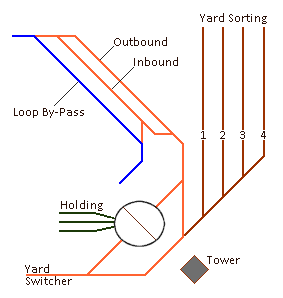 |
The yard has arrival and departure tracks that parallel along the
outside of the Cumberland loop. It also has four sorting tracks, a
turntable and multiple motive power hold tracks off the turntable. It
also has a full time yard switcher. |
|
Arriving trains will have their cars picked up by the yard switcher
while the motive power, crew cars and caboose are turned on the
turntable. Train crews may be held while cars are sorted for the next
local or through freight. |
|
Locals sent out should return to the yard they were sent from unless
otherwise directed. |
|
